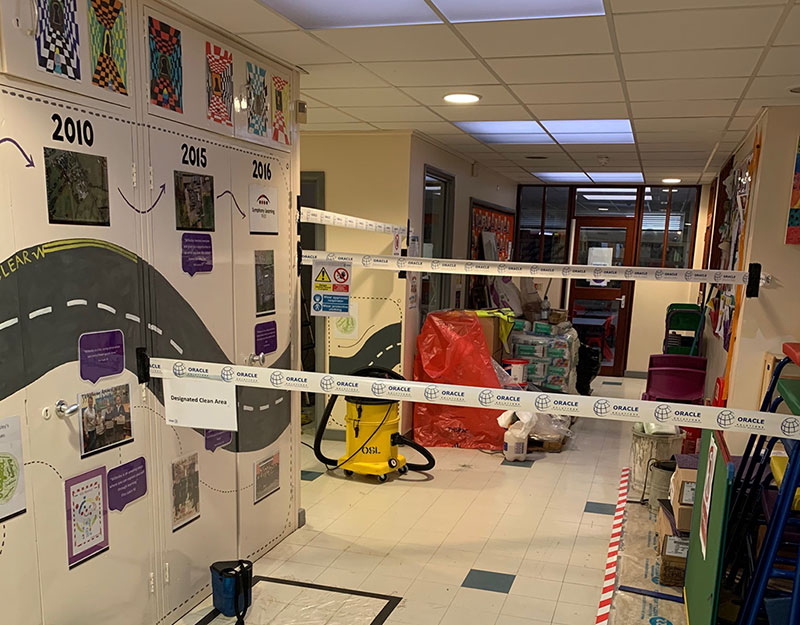Managing Asbestos in Schools: What You Need to Know
So, what do you need to know about the presence and management of asbestos materials in schools for which you may be responsible? Below, we have set out the essentials.
What is asbestos and why is asbestos dangerous?
Asbestos is a group of naturally occurring, fibrous silicate minerals, which were widely used in many industries in the UK – including construction – for much of the 20th century.
Formerly a ‘go-to’ material for all manner of construction projects due to its relative affordability, easy availability, strength, and fire resistance, asbestos later became notorious due to the serious health risks it was found to pose to those who breathed in its fibres.
If someone inhales or ingests asbestos, they run the risk of eventually – potentially many decades after the moment of exposure to the substance – developing an asbestos-related disease, such as mesothelioma or asbestos-related lung cancer. These health conditions are frequently fatal.
As a consequence of increasing awareness of these health dangers, asbestos was eventually banned altogether in the UK in 1999.
Is asbestos still present in schools?
The short answer to this question is: yes. As the Department for Education has stated in guidance last updated in 2020, “most school and college buildings contain asbestos.”
Although the aforementioned ban means that asbestos is no longer used by the UK construction industry, the naturally occurring fibres are still present in many buildings put up before the year 2000; it has been reported that around 85% of schools in the UK still have asbestos in their buildings.
Understanding the risk of asbestos exposure in schools
With the use of asbestos having been particularly widespread in the 1950s and 1960s – the substance being frequently chosen back then on account of its insulation properties and fire protection resistance – buildings erected during these decades are even likelier to still contain the material giving rise to concerns about asbestos problems in buildings.
Indeed, the mid-20th century – a time before the dangers of the substance to health and safety became widely known among workers and the public – saw asbestos added to almost many types of construction and building materials.
According to the Health and Safety Executive (HSE), “asbestos that is in good condition and unlikely to be damaged or disturbed is not a significant risk to health as long as it is properly managed.”
The UK Government agency has said that this means school teachers and pupils are “unlikely” to be put at risk of being exposed to asbestos materials during their usual activities. However, it has said that activities posing a possible risk of causing damage to asbestos-containing materials (ACMs) – such as pinning or tacking work to insulation board or asbestos ceiling tiles – should be avoided.
Research conducted in 2018 found that there were five times more deaths from mesothelioma – a type of cancer almost always arising from direct contact with asbestos – among teachers than would be expected in populations that have not been exposed to asbestos.
It is a saddening reminder that the risks of school staff breathing in this potentially lethal material, possibly without even being aware of it, are likely still very real.
Where can asbestos be found in schools?
There is a wide range of areas within a school building put up before the year 2000, in which some form of asbestos products might be present.
Asbestos lagging, for instance, was once commonly used as thermal insulation on pipes and boilers, while sprayed asbestos and asbestos-insulating board (AIB) also saw frequent use for partitioning and ducts. The asbestos material can also be found in some ceiling tiles, as well as in floor tiles, cement roofing and guttering, and textured coatings.
What is the current status of asbestos in schools?
As aforementioned, asbestos is likely to be present in at least some buildings in the majority of schools in the UK, such was the material’s widespread use in construction from the 1950s until the 1990s. Concerning news headlines have also continued to emerge on the subject of the asbestos that remains in schools, and the risks that the material might still pose.
Those stories have included – in July 2019 – reports that almost 700 schools in England had been referred to the HSE over concerns that they were failing to safely manage asbestos on their premises, thereby potentially putting school staff and students at risk. It was reported then by The Guardian that about 90% of school buildings in England were believed to still contain asbestos.
In May 2022, it was further reported that a widow whose husband passed away following his diagnosis with a lung cancer thought to have been caused by school-based exposure to asbestos, said it was his teaching career that “ultimately killed him”.
Carol Plater said to the i that her husband John was “an amazing character” who dedicated himself to teaching. She added that he had been fit and healthy – being a keen skier and rock climber – until he began suffering abdominal pains in September 2019.
Mr Plater was diagnosed with mesothelioma in January 2020, and very sadly died in February 2021.
His widow said that he had qualified as a school teacher in 1974, and that it is believed his main asbestos exposure happened five years later at an East Sussex school, where he worked “in a new workshop with a metal heating area which was lagged with asbestolux. He flagged it, but he was told it was fine.”
According to data from the Office for National Statistics (ONS), a total of 305 teachers are confirmed to have died from mesothelioma between 2001 and 2016. And John McClean, of the Joint Union Asbestos Committee, recently said that 102 teachers and educational professionals had died from mesothelioma during 2019 alone.
Indeed, he expressed fears that the true numbers of deaths for teachers exposed to asbestos may be even higher than those officially shared, due to the fact that “anyone who dies over the age of 75 is not recorded as an industrial death.”
He added: “Also, the HSE records mesothelioma deaths by the last profession someone worked. So, if someone worked as a teacher for many years and then took retirement and worked as something else before their death, their occupation would not be listed as a teacher.”
Lynne Squibb, chief executive of the Hampshire Asbestos Support Awareness Group (Hasag) charity, said: “We have lobbied the Government and written to MPs for many years asking for a planned removal of asbestos from state schools, but they keep telling us that the HSE say asbestos is safe to remain in schools if it is properly maintained.
“But I don’t think we would be seeing rising numbers of teachers dying of asbestos-related disease if this was the case… we feel the Government won’t commit to removing asbestos because of the expense.”
Who is responsible for managing asbestos in schools?
For clarity on who is the ‘duty holder’ with regard to asbestos management in schools, one has to look to Regulation 4 of the Control of Asbestos Regulations 2012. This regulation states that anyone who is responsible for maintaining and/or repairing non-domestic premises – such as a school – has the role of ‘duty holder’.
In practice, in the case of schools, it is generally the employer that is the ‘duty holder’. However, the exact identity of the ‘employer’ will depend on the type of school.
So, in the case of community schools, voluntary-controlled schools or maintained nursery schools, it is the local authority that will be the ‘employer’. But if the institution is an academy or free school, it is the school governors who be the ‘employer’, and at independent schools, it may be the proprietor, governors or trustees who have this role.
If your school has its building management budget delegated to it by the local authority, the duty to manage asbestos will be shared between the local authority and the school.
For the financing of maintained schools, the local authority will have a written scheme stipulating the categories of work that will either be financed from the delegated school budget share or remain the local authority’s responsibility. It will therefore effectively be both parties that have responsibilities as ‘duty holders’ as far as the maintenance and repair of the premises is concerned.
What happens when asbestos is found in schools?
Duty holders have a series of responsibilities with regard to asbestos management in their school. These include – as outlined by the health and safety executive (HSE) – keeping an up-to-date record of where asbestos containing materials (ACMs) are located on the school premises, and the condition of those materials.
As part of the asbestos management responsibilities, it is also expected that the dutyholder will assess the risks that any given asbestos containing materials pose within the buildings, in addition to making and implementing plans for managing asbestos in schools and the risks that it poses.
So, in practice, what should happen if asbestos is discovered on your school property? The plans that you put together – and put into action – should include one or more of the below elements.
Maintenance
Are the asbestos fibres on the school premises in good condition? If so, you should prepare a plan designed to ensure they remain in this condition. It should be detailed in the plan what kind of maintenance needs to be carried out in order to achieve this.
Repair
There may be a need for maintenance personnel to carry out repairs to pipe or boiler coverings that have sustained damage, and it is possible that these coverings may contain asbestos. These are normally modest repair jobs where there might only be a small amount of asbestos fibres present. You may need to arrange for a licensed professional to carry out this work.
Encapsulation
The step might be taken in some cases of spraying a thick, paint-like sealant on exposed asbestos materials, to secure them in place so that asbestos fibres aren’t released later. This is a process known as ‘encapsulation’.
Enclosure
This is a process not unlike encapsulation, except that it entails surrounding the asbestos with an airtight barrier, created from a material such as wood or metal.
Removal
While the entire removal of asbestos isn’t always chosen, as it may be judged that asbestos removal isn’t necessary or cost-effective, it is nonetheless the only solution in this list that would completely take away the risk of the asbestos being disturbed or damaged at some point in the future. This task typically involves the asbestos containing materials being removed and replaced with materials that do not contain asbestos.
Given the extremely high levels of risk involved when dealing with asbestos in any type of building, if you are in doubt about the processes or requirements for any of the above elements of an asbestos management plan, you are urged to get in touch with a reputable asbestos consultancy that can provide more specific advice and guidance.
Does a school have to close if it thinks it has an asbestos problem?
The answer to this question will depend on such factors as the location of the asbestos-containing materials, the type of material, and the potential impact of this material on the ability of students and staff to safely access and use the site.
If, for instance, asbestos is only found in a boiler room or another part of the site that is not accessible to the rest of the school and the children, the school will not need to close, as it will be possible to seal off the area where the asbestos is present.
In the event, however, of the asbestos materials being present in a more intrusive location such as a corridor, or access to essential parts of the school only being possible through common areas, you will need to shut the school, or arrange to have any work on the asbestos materials carried out during the school holidays.
Should parents be told about asbestos in their children’s school?
There isn’t currently any health and safety legislation that requires a school to let parents know there is asbestos in their children’s school. However, if you are responsible for a school, you might choose to provide parents with some information on the measures you have in place for controlling the risk of asbestos, so that they can be reassured.
Furthermore, in the event of a failure in the management of asbestos at your school site that causes an accidental release of asbestos fibres, you should inform those affected of this risk.
Should parents be concerned about asbestos in schools?
As we touched on earlier, it is believed that most school premises – perhaps as many as nine in 10 – still contain asbestos. This might seem an alarming number, but it is important to appreciate that the level of risk the asbestos poses will depend greatly on what the school is doing to manage risk on its site.
It is not believed that ACMs will generally pose a health risk, if they are in good condition and undisturbed. This is because in many cases, only disturbance to the asbestos materials will cause the asbestos fibres in the materials to become airborne, thereby heightening the chances of someone nearby breathing them in.
It is thought that disturbance of asbestos materials will only normally occur on a school site if an accident occurs, or if maintenance or construction work takes place on the site that was not properly planned for to ensure safety. Thankfully, the HSE has said that where it has undertaken inspections of schools, it has found that most have good standards for managing asbestos in their buildings.
According to the HSE, even in schools where asbestos is present, teachers and pupils are unlikely to be put at risk over the course of their usual activities on a school site. They are, however, urged not to undertake activities that could present some risk of damaging ACMs, such as pinning or tacking work to insulation board or ceiling tiles.
Here at Oracle Solutions, we can be very much that company! So, please do not hesitate to contact us or give us a call about any of our services today.

Written by Jess Scott
Jess Scott has been an all-round asbestos consultant since 1996. That’s nearly 3 decades of asbestos knowledge. He spends his time sharing that knowledge with the team at Oracle and with their clients. Jess's goal is, and always has been, to use my expertise in helping people to comply with the law. This legal compliance ultimately helps to protect everyone from the harmful effects of asbestos. Jess has acted as an asbestos expert witness in legal cases and is involved in many asbestos educational activities throughout the UK.


